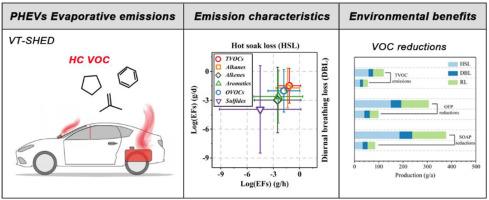轻型插电式混合动力汽车挥发性有机化合物挥发性排放的实验室表征:与传统汽车的环境影响比较
IF 7.3
2区 环境科学与生态学
Q1 ENVIRONMENTAL SCIENCES
引用次数: 0
摘要
插电式混合动力汽车(phev)在降低燃料消耗和尾气排放方面是有效的。然而,对它们对蒸发排放的贡献,包括所释放的挥发性有机化合物(VOCs)的性质及其随后的环境效益,缺乏全面的了解。为了填补这一空白,采用变温密封壳体蒸发测定(VT-SHED)方法对轻型插电式混合动力汽车进行了蒸发排放测试。本研究表征了挥发性有机化合物(VOC)的蒸发排放因子(EFs)、源概况和不同操作条件下的大气反应性。然后将这些发现与遵循相同中国六国排放标准的传统内燃机汽车(icev)进行比较,从而评估挥发性有机化合物(VOC)蒸发排放量的减少以及插电式混合动力车提供的整体环境优势。主要研究结果表明,插电式混合动力汽车产生的总VOC (TVOC) EFs在热浸损失(HSL)下为0.07±0.04 g/h,在日呼吸损失(DBL)下为0.03±0.01 g/d。在HSL和DBL过程中,具有高饱和压力的轻烃(C2、C4和C5种)是主要的VOC贡献者。随着蒸发温度的升高和持续时间的延长,车辆VOC排放的OH损失率和二次污染潜能值呈指数增长。这些结果表明,与内燃机汽车相比,一辆插电式混合动力汽车每年可减少54.44%的TVOC排放。插电式混合动力汽车的蒸发控制系统成功地降低了芳烃排放,臭氧形成势(OFP)降低了66.08%,二次有机气溶胶势(SOAP)降低了93.85%。重要的是,当插电式混合动力汽车在电动模式下长时间运行时,观察到一个关键的差异,在此期间,它们的VOC排放量可能大大超过内燃机汽车。这突出了它们的排放行为的一个重要但经常被忽视的方面。这些结果促进了我们对插电式混合动力车排放特征的理解,并为未来的车辆设计策略和环境政策举措提供了信息。本文章由计算机程序翻译,如有差异,请以英文原文为准。

Laboratory characterization of VOC evaporative emissions from light-duty plug-in hybrid electric vehicles: Environmental impact comparison with conventional vehicles
Plug-in hybrid electric vehicles (PHEVs) are effective in reducing fuel consumption and tailpipe emissions. However, a comprehensive understanding of their contribution to evaporative emissions, including the nature of volatile organic compounds (VOCs) released and their subsequent environmental benefits, is lacking. To fill this gap, evaporative emission tests were performed on light-duty PHEVs using the variable temperature sealed housing evaporative determination (VT-SHED) method. This investigation characterized VOC evaporative emission factors (EFs), source profiles, and atmospheric reactivity across various operating conditions. These findings were then compared against conventional internal combustion engine vehicles (ICEVs) adhering to the same China VI emission standards, allowing for an assessment of VOC evaporative emission reductions and the overall environmental advantages provided by PHEVs. Key findings indicate that PHEVs generated total VOC (TVOC) EFs of 0.07 ± 0.04 g/h for hot soak loss (HSL) and 0.03 ± 0.01 g/d for diurnal breathing loss (DBL). In both HSL and DBL procedures, light hydrocarbons (C2, C4, and C5 species) with high saturation pressures were the dominant VOC contributors. Furthermore, the OH loss rate (LOH) and secondary pollution potential of vehicle VOC emissions exhibited an exponential increase with elevated evaporation temperature and prolonged duration. These results demonstrate that a single PHEV annually reduced TVOC emissions by 54.44% when compared to ICEVs. The evaporative control system in PHEVs successfully reduced aromatic hydrocarbon emissions, resulting in a 66.08% decrease in ozone formation potential (OFP) and a 93.85% decrease in secondary organic aerosol potential (SOAP). Importantly, a key difference is observed when PHEVs operate in electric mode for extended periods, during which their VOC emissions may considerably exceed those of ICEVs. This highlights an important yet often overlooked aspect of their emission behavior. These results advance our understanding of PHEVs’ emission profiles and inform future vehicle design strategies and environmental policy initiatives.
求助全文
通过发布文献求助,成功后即可免费获取论文全文。
去求助
来源期刊

Environmental Pollution
环境科学-环境科学
CiteScore
16.00
自引率
6.70%
发文量
2082
审稿时长
2.9 months
期刊介绍:
Environmental Pollution is an international peer-reviewed journal that publishes high-quality research papers and review articles covering all aspects of environmental pollution and its impacts on ecosystems and human health.
Subject areas include, but are not limited to:
• Sources and occurrences of pollutants that are clearly defined and measured in environmental compartments, food and food-related items, and human bodies;
• Interlinks between contaminant exposure and biological, ecological, and human health effects, including those of climate change;
• Contaminants of emerging concerns (including but not limited to antibiotic resistant microorganisms or genes, microplastics/nanoplastics, electronic wastes, light, and noise) and/or their biological, ecological, or human health effects;
• Laboratory and field studies on the remediation/mitigation of environmental pollution via new techniques and with clear links to biological, ecological, or human health effects;
• Modeling of pollution processes, patterns, or trends that is of clear environmental and/or human health interest;
• New techniques that measure and examine environmental occurrences, transport, behavior, and effects of pollutants within the environment or the laboratory, provided that they can be clearly used to address problems within regional or global environmental compartments.
 求助内容:
求助内容: 应助结果提醒方式:
应助结果提醒方式:


